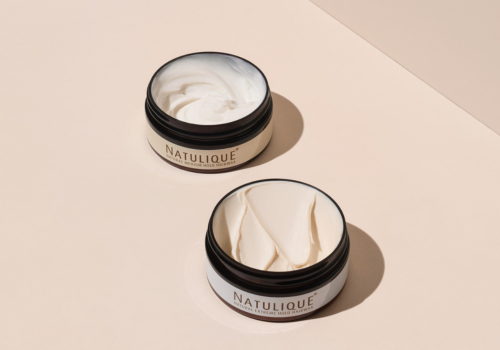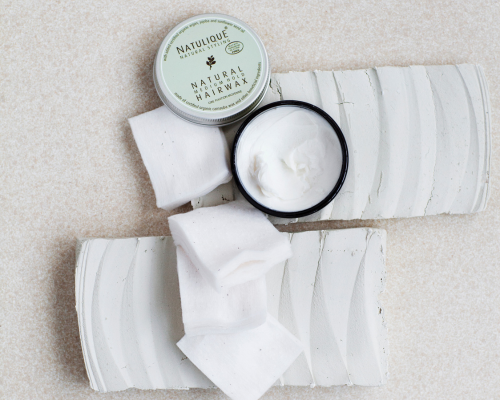Introduction to hair wax
Definition of hair wax
Hair wax is a popular styling product used to flexibly shape and set hair. It's usually made from natural or synthetic waxes, such as beeswax, combined with oils or emulsifiers to create a malleable texture. Unlike styling gels, wax does not dry out the hair and offers a natural finish. This product is prized for its ability to add volume while allowing multiple re-stylings throughout the day, which is particularly appealing to those seeking to avoid a staid look.
Types of hair wax
- Beeswax : Natural and gentle, it offers good hold while nourishing hair.
- Clay-based wax : Provides a matte finish and is ideal for fine hair as it does not weigh hair down.
- Kerosene wax : Synthetic, it offers long-lasting adhesion but can be more difficult to remove.
- Water-soluble wax : Easy to wash, this wax is perfect for daily use without excessive product build-up.
Use and general benefits of hair wax
Hair wax is a versatile product suitable for a variety of hairstyles, from tousled looks to more elegant, well-groomed styles. It is particularly appreciated for its ability to provide flexible hold without stiffness, allowing hair to be shaped at will while ensuring relative durability.
Examples of use in different hairstyles
- Dishevelled look: For a textured, natural effect, apply a small amount of wax to slightly damp hair and comb through with your fingers.
- Pompadour style: Wax can be used to add volume and hold strands in place. Work the product into the roots and style hair backwards.
- Short, structured cuts: Use wax to sculpt and define strands, creating a clean, contemporary look.
- Wet-look hairstyles : Apply a light wax to wet hair for a shiny, tidy look.

Characteristics of fine hair
Description of fine hair
Fine hair is characterized by its smaller diameter than other hair types. It is often silky and delicate to the touch, but can lack volume and thickness. This type of hair is more likely to appear flat and lifeless if the right styling techniques are not applied. What's more, fine hair tends to break more easily, which can affect the overall appearance of the hair.
Common causes of fine hair
Several factors can lead to the appearance of fine hair. Biologically, some people may simply inherit naturally fine hair. However, other factors such as hormonal imbalances, nutritional deficiencies or aggressive hair treatments can also lead to a reduction in hair volume. Aging, stress and certain health problems can also contribute to this condition, making hair more vulnerable and brittle.
Common challenges of fine hair care
Caring for fine hair can be tricky. This type of hair requires special care to prevent it from becoming greasy or rapidly losing its volume. The wrong choice of product can easily weigh hair down, accentuating its fine appearance and lack of fullness.
Recommendations for caring for fine hair
- Use volumizing shampoos: These products are specifically designed to give hair a thicker look without making it heavy.
- Apply light conditioners: Choose formulas that condition without weighing down, concentrating mainly on the ends to avoid build-up on the scalp.
- Dry carefully: Use a soft towel to absorb excess moisture rather than rubbing vigorously, which can damage hair.
- Choose appropriate hairstyles: Layered cuts or styles that add the illusion of volume are recommended to amplify the appearance of fine hair.
- Avoid products containing silicone: These ingredients can weigh hair down and lead to an annoying build-up of residue.
See also: How do you achieve even bleaching all over your hair?
Is hair wax suitable for fine hair?
Effects of hair wax on fine hair
Benefits of hair wax for fine hair
There are several benefits to using hair wax on fine hair. Firstly, wax can provide a light structure that helps give the impression of volume. Thanks to its malleable texture, wax can shape hair flexibly, which is essential for fine hair that tends to lose volume over the course of the day. What's more, unlike gels, wax doesn't harden hair, preventing a cardboard-like appearance and preserving a natural look.
Another advantage is the ability to touch up the style throughout the day without having to reapply product. In fact, hair styled with wax can be easily reshaped, which is particularly useful for those who like to change their style or who need to maintain an impeccable hairstyle all day long. This flexibility also reduces stress on fine hair, limiting the risk of breakage.
Potential risks of using hair wax on fine hair
Despite its many advantages, the use of hair wax can also present certain risks for fine hair if not used correctly. One of the main problems is the risk of product build-up, which can weigh hair down and cause it to lose its natural lightness. Excessive use can leave hair looking greasy and flat, contradicting the desired result.
It's also crucial to wash hair thoroughly after using wax to avoid any residue. Non-water-soluble waxes may sometimes require a clarifying shampoo to be completely removed. This step is essential because, without it, hair can become dull and lack vitality. For this reason, we recommend using a wax suitable for fine hair, generally a light, easy-to-rinse formula.
Comparison with other styling products for fine hair
Choosing wax over other products
When comparing hair wax to other popular styling products for fine hair, such as mousse or spray, several distinctions emerge. Mousse, for example, is often chosen for its volumizing effect and lightness. It leaves almost no residue and is fairly easy to remove, eliminating worries about build-up in fine hair. However, the hold offered by mousse is not as long-lasting as that of wax.
Styling sprays offer firm hold and a glossy finish, but they can sometimes dry out delicate hair, which is a major drawback for fine hair. What's more, sprays tend to stiffen styles, lacking the flexibility offered by wax, which can be reshaped throughout the day with no problem.
So, choosing between wax and other styling products depends on personal styling preferences and how you wish to manage the texture and shape of your hair. In line with wax's versatility, its choice would be ideal for those seeking adjustable hold and subtle volume, while taking care to remain vigilant about application and hair care after use.
Tips for using hair wax on fine hair
Applying hair wax
To get the most out of hair wax on fine hair, it's crucial to master its application. Start by measuring out the right amount of wax. A small amount is often enough to achieve the desired effect. Warm it lightly between your palms to liquefy it before applying it evenly to your hair. Concentrate on lengths and ends rather than roots to avoid weighing hair down.
Preferred styling techniques
- Texturing : To add volume and texture, apply wax directionally with your fingers, working from roots to tips.
- Reinforcement : To maintain a structured cut, apply wax to the sections you want to set, using a comb for sharper definition.
- Touch-ups : Use the wax throughout the day to adjust your style without adding product, simply reactivating the wax already present in the hair.
Frequency of use and maintenance
Although hair wax is ideal for achieving a variety of styles, it's best not to use it on a daily basis. Alternate with wax-free days to let your hair breathe. Regular cleansing with a mild or clarifying shampoo will help remove any wax residue, keeping your hair light and healthy.
Common mistakes to avoid
- Product overload : Avoid applying too much wax, which can leave hair greasy and flat.
- Incorrect application: Do not concentrate the product on the roots to avoid weighing down fine hair.
- Omission of washing : Be sure to wash your hair thoroughly to avoid unwanted wax build-up.
FAQ
-
Is hair wax more suitable for men or women?
Hair wax is suitable for both men and women, depending on style and hair type. It can be used universally by anyone seeking versatility and hold without stiffness.
-
Which hair wax is right for fine hair?
Fine hair benefits from a lightweight wax, such as a clay-based or water-soluble wax, which doesn't weigh hair down and is easy to rinse out.
-
Can I use hair wax if I have an oily scalp?
Yes, but use it sparingly and avoid applying it to the roots to avoid accentuating sebum production.
-
How do I remove hair wax residue?
Using a clarifying shampoo once or twice a week is effective for removing stubborn wax residues.
-
Does hair wax damage fine hair?
No, if used correctly and cared for regularly, hair wax should not damage fine hair.



